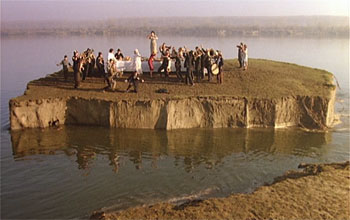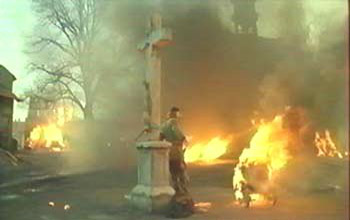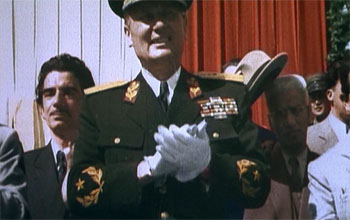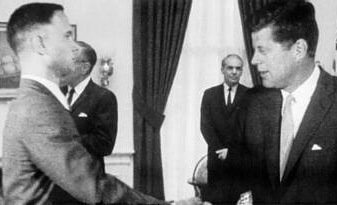|
Keys for Underground |
Here are some keys on all the symbols used in the film Underground...

- The Belgrade zoo bombardment is a real fact (here is a picture of today's zoo entrance). In 1941 many animals actually escaped in the city adding to terror the surrealistic note we see in the film. Emir absolutely wanted to have a lion ("a zoo without lion, it is not a zoo!"), in spite of the logistic difficulties that that implied. Beyond the symbolic value evoked by each animal (birds locked up in the birdcage, the swan which rebels against the tiger, the Feliniesque elephant, etc), one can see this gigantic capharnaüm like the release of the wild instincts at the time of the War. It is the law of the jungle, the law of the strongest which is announced. To survive, it will be necessary to fight...
- Although the characters of Blacky and Marko are introduced like characters of fiction, they have the same nickname as two real people of this period : Milan Rankovic and Sreten Zujovic, two Serbs, close of Tito. Just like Rankovic, Marko is a manipulator, and just like Zujovic, Blacky took after the war the control of commando groups...
- During the war, Marko comments on the second serie of bombardments : "When it is not the German who bombard us, the allies do it...". This sentence takes almost prophetic forms with the NATO interventions in 1999.
- The historical images were carefully selected by Emir Kusturica in the files of Yugoslav television : one can notice that the Nazi armies are acclaimed in Ljubliana (capital of Slovania) and in Zagreb (capital of Croatia), but not in Belgrade (capital of Serbia). Indeed, the Serb have often considered the Croatian and Slovens as collaborationnists with the enemy.
- The strongest symbol - and it is also the title of film - is that of the cellar. Obviously, it evokes Plato and the cave allegory where people locked up have only a deformed vision of external reality, vision orchestrated by Marko. But more than that, the cellar represents also the whole Yugoslavia of Tito in all its diversity : each people, each generation and each religion are represented there ; but also Blacky wants to prove to Marko that even insulated (Titist Communism had broken with that of Staline), they can manage themselves to achieve great things. And Blacky shows the M-84 tank they built. This tank was indeed the great pride of Tito : he wanted absolutely that this tank was the result of assemblied parts manufactured in all the provinces of the country.
- Finally, Soni the monkey is the only character to cross the film from the beginning to the end... Whereas generally, the monkey symbolizes sillyness, stupidity, here it is him who opens the way out of the cellar, him who shows to Yovan how to eat a banana (without the skin), him who finds the way back to the cellar in the labyrinth, etc.
- The sequence where a ground area is torn from the river at the end of film is itself so much a summary of the whole symbols of the film. The herd of cows leaving water represents the souls of the deads who come back in a new body (without handicap) to have fun and to forgive. The formed island has obviously the shape of Bosnia-Herzegovina and its distance to the bank can symbolize the cultural distance (incomprehension ?) compared to the rest of Europe, or a new departure ?
- In one of the last scenes of the film, where Emir Kusturica is a weapon dealer, we have a condensed view of the reproaches Emir Kusturica has against his country : the blue helmets let do (and protect) the weapon dealers, the population deportations, the "war profiteurs" who are hated by those who fight, the dealers who made fortune in (or thanks to ?) Germany, the rise of the uncontrolable para-military groups, fast after-the-war judgements, with no trial ...
- Finally, and close to polemic, one can say that Marko symbolizes Tito, and that it is consequently a denunciation of the Communism which handled, criminalised and servilised the Yugoslav population by maintaining it away from the evolutions of the world, under a lead cap ; and that Blacky represents Slobodan Milošević, when the people become aware that he was lied, he is a necessary leader for those who do not accept orders from anybody (see the dialogue with the blue helmet: "who is your leader ? - I do not have a leader. My leader, it is my country, fucking fascist motherfucker...")
The best being of course always to have its own idea... as with this scene of Underground and this painting of Marc Chagall, entitled The War :"I find myself a little like Chagall, in the way that I use the same scale of colors and topics : people who marry, who divorce... There is something which belongs to the orthodoxe culture of the East, somthing I know very well. It is a culture which does not establish any separation between the human emotions... "
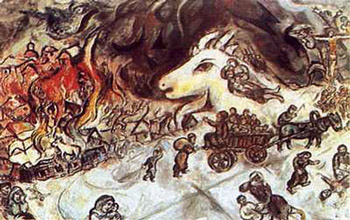
... or with the underwater sequences, which are a true homage to the film L'Atalante by Jean Vigo, a film for which Emir Kusturica has a great admiration :"I believe that this film of Jean Vigo completely changed my illusions on the revolutionary character of the cinema. It is the poetry which makes the cinema. If you want to last, you have to be a poet ; if you're not a poet, the films you make can just be reflexions... Fifteen years ago, all seemed much easier to to me ; today, the things became rough. It is much more difficult to survive as a poet in the jungle of the modern cinema... Nobody knows what it means anymore. I remain persuaded that in L' Atalante, you find the perfect balance between dialogue and action [... ] The flying bride we see under the water... it is a certain form of homage to L' Atalante by Jean Vigo. But then, it became something much more significant, everyone dies and derives under water. "

Released just a few months after the movie Forrest Gump, it is interesting to notice the many common points between the two films. first of all formally, since they both use the same actors incrustation process in stock files. But also in the ideas, since this process is used to make the audience believe that the fictionnal characters have met and influenced major people of history, thus reinforcing the authentic and credible aspect of the scenes.
